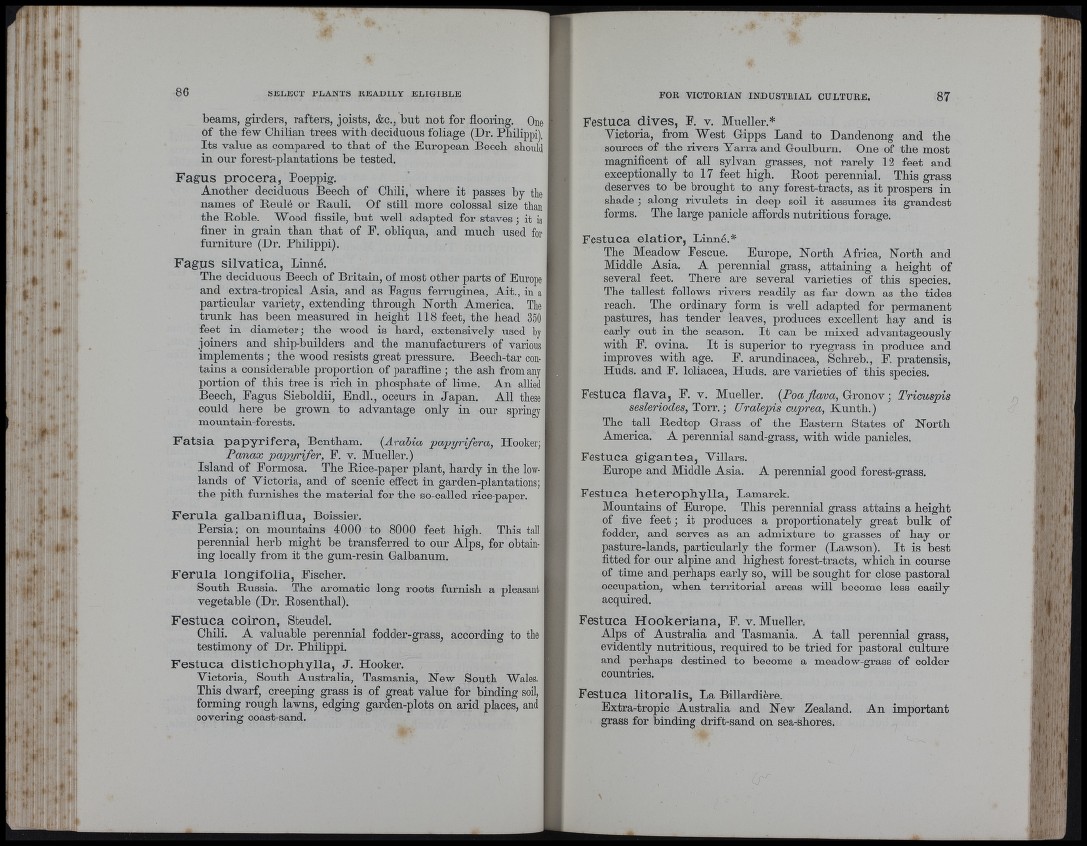
¡'I
,
it'
1 1 1
i l i
U l i j
8 6 SELECT PLANTS READILY ELIGIBLE
beams, gii'ders, rafters, joists, &c., but not for flooring. One
of tlie few Chilian trees with deciduous foliage (Dr. Philippi),
Its value as compared to that of the European Beech should
in our forest-plantations be tested.
Fagus procera, Poei^pig.
Another deciduous Beech of Cbili, where it passes by the
names of Beulé or Raiili. Of still more colossal size than
the Boble. Wood fissile, bnt well adapted for staves; it is
finer in grain than th a t of F. obliqua, and much used for
furniture (Dr. Philippi).
Fagjis silvática, Linné.
The deciduous Beech of Britain, of most other parts of Europe
and extra-tropical Asia, and as Eagus ferruginea. Ait., in a
particular variety, extending through North Ameidca. The
trunk has been measui’ed in height 118 feet, the head 350
feet in diameter; the wood is hard, extensively used by
joiners and ship-builders and the manufacturers of various
implements ; the wood resists great pressure. Beech-tar contains
a considerable proportion of paraffine ; tbe ash from any
portion of this tree is rich in phosphate of lime. An allied
Beech, Fagus Sieboldii, Endl., occurs in Japan. All these
could here be grown to advantage only in our springy
mountain-forests.
Fatsia papyrifera, Bentham. {Arabia papyrifera, Hooker;
Panax papyrifer, F. v. Mueller.)
Island of Formosa. The Bice-paper plant, hardy in the lowlands
of Victoria, and of scenic effect in garden-plantations;
the pith furnishes the material for the so-called rice-paper.
Ferula galbaniflua, Boissier.
Persia; on mountains 4000 to 8000 feet high. This tall
perennial herb might be transferred to our Alps, for obtaining
locally from it tbe gum-resin Galbanum.
Ferula longifolia, Fischer.
South Russia. The aromatic long roots furnish a pleasant
vegetable (Dr. Rosenthal).
Festuca coiron, Steudel.
Chili. A valuable perennial fodder-grass, according to the
testimony of Dr. Philippi.
Festuca distichophylla, J . Hooker.
Victoria, South Australia, Tasmania, New South Wales.
This dwarf, creeping grass is of great value for binding soil,
forming rough lawns, edging garden-plots on arid places, and
covering coast-sand.
FOR VICTORIAN INDUSTRIAL CULTURE. 87
Festuca dives, F. v. Mueller.*
Victoria, from West Gipps Land to Dandenong and the
sources of the rivers Yarra and Goulburn. One of the most
magnificent of all sylvan grasses, not rarely 12 feet and
exceptionally to 17 feet high. Root perennial. This grass
deserves to be brought to any forest-tracts, as it prospers in
shade; along rivulets in deep soil it assumes its grandest
forms. The large panicle affords nutritious forage.
Festuca elatior, Linné.*
The Meadow Fescue. Europe, North Africa, North and
Middle Asia. A perennial grass, attaining a height of
several feet. There are several varieties of this species.
The tallest follows rivers readily as far down as the tides
reach. The ordinary form is well adapted for permanent
pastures, has tender leaves, produces excellent hay and is
early out in the season. I t can be mixed advantageously
with F. ovina. I t is superior to ryegrass in produce and
improves with age. E. arundinacea, Schreb., F. pratensis,
Huds. and E. loliacea, Huds. are varieties of this species.
Festuca flava, F. v. Mueller. {Poa flava, Gronov ; Tricuspis
sesleriodes, Torr. ; Uralepis cuprea, Kuntb.)
The tall Redtop Grass of the Eastern States of North
America. A perennial sand-grass, with wide panicles.
Festuca gigantea, Villars.
Europe and Middle Asia. A pei’ennial good forest-grass.
Festuca heterophylla, Lamarck.
Mountains of Europe. This perennial grass attains a height
of five feet ; it produces a proportionately great bulk of
fodder, and serves as an admixture to grasses of hay or
pasture-lands, particularly the former (Lawson). I t is best
fitted for our alpine and highest forest-tracts, which in course
of time and perhaps early so, will be sought for close pastoral
occupation, when territorial areas will become less easily
acquired.
Festuca Hookeriana, E. v. Mueller.
Alps of Australia and Tasmania. A tall perennial grass,
evidently nutritious, required to be tried for pastoral culture
and perhaps destined to become a meadow-grass of colder
countries.
Festuca litoralis, La Biliardière.
Extra-tropic Australia and New Zealand. An important
grass for binding drift-sand on sea-shores.
I *
¿ ñ
1.' ,
W:.
t ’
■J